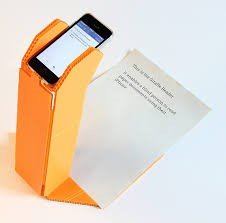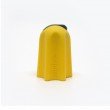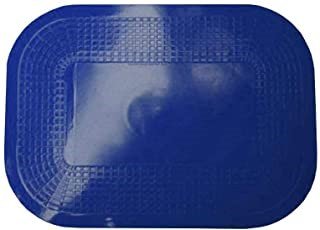By Rona Smith.
When it comes to independence, cooking is a crucial skill that blind and visually impaired people must learn. But the kitchen can be a very visual environment.
So how do you master this potentially difficult and dangerous part of everyday life? Rona Smith has compiled a list of tips that can help.
1. Spread with a spoon.
For spreading smooth spreads, you may find it easier to use the back of a desert spoon instead of a knife. This is because sometimes with a knife, you could accidentally spread too hard and break the bread.
2. Spice up your life
Label your spices in Braille, or with Penfriend labels, so that you know what they are.

Find a braille labeller at the RNIB Shop
3. Season to taste
Salt and pepper grinders are easier to manage and control than shakers.
4. Break some eggs
For breaking eggs, bang the egg shell against the edge of a cup, pull the 2 halves apart and depending on how well you cracked it, it should go neatly into the cup.

5. Brush on some oil
If you need to oil a tray, tin or cup, you can use a pastry brush.
6. Accessible jugs
Use a talking measuring jug or a jug with clear Braille markings on it for measuring liquids so that it is accurate.

Find a talking measuring jug online
7. Pastry tip
When brushing pastry with milk, you will not need a lot.
8. Tray magnifique!
Use a tray to help you keep everything organised and contained.
9. App it up
Use a scanning app such as: Seeing AI or Envision AI along with a giraffe scanning stand to help you read the cooking instructions on packaging.

Find out more about Giraffe stands here
10. Get a handle on it
When placing a pan on the hob, always make sure that the handle is consistently at one side so you know where it is and don’t burn yourself.
11. Safer pasta
When boiling pasta, start from cold water, because this is safer and it cooks it quicker.
12. Spread tip
Margarine in a tub is easier to use than butter in a block.
13. A grate idea
Buying pre-grated cheese is easier and safer than grating cheese by hand.
14. A pasta portion tip
If you empty pasta into a plastic cereal container with a flip lid, it is then easier to manage and measure out handfuls. It helps to prevent spillages caused by a rip in the packet. Also, consider using Penne pasta or another large pasta shape as these will be easier to grab handfuls from.
15. Soup-er tip
It is easier and safer to buy tins of soup that have a ring pull than trying to use a can opener. If you are using a tin that has a ring pull, you may find that you need a spoon that can be placed in the gap to help you start the ring pull off.

16. Protect your fingers
A Nimble device is useful for opening certain types of plastic packaging.

17. Buy the right bread
Square-shaped sliced bread is easier than other types of sliced bread, because it allows you to feel the edges more clearly to enable you to spread butter more effectively.
18. Squeezier is Easier
Buy squeezy jars of mustard and marmite as they will be easier to use than the standard jars.

19. A great McTip
When making burgers, weigh out your mixture and then divide it into 4 equal portions. This will ensure that all of the burgers are the same size.

Find a simple homemade burger recipe here.
20. Get a helping hand
When shopping for your ingredients, you can either ask a member of staff to read out jars, bottles, boxes and other packaging for you or you can use Envision AI or Seeing AI on the “Read text instantly” function to read labels on packaging. You could also shop with a friend or relative who can read the product information for you. Alternatively, you can do online shopping where you can access information about products using a screen reading software such as: NVDA (Non-Visual Desktop Access), Jaws or Supernova and the shop may do deliveries for you.

Find out about Seeing AI here.
Find our about Envision AI here.
For a comparison of accessible computer software
21. Location, Location, Location
When you buy ingredients, be consistent in where you put them each time you buy each kind of item. This will ensure that you know where things are so that you can find them more quickly and efficiently.

22. Never overfill a cup again
When pouring liquids into cups for example: when making tea, use a Liquid Level Indicator. This device has metal prongs that fit into the inside rim of a cup and it beeps when the cup is full. This ensures that you don’t spill water everywhere and make a mess.

Find liquid level indicators here.
23. Tactile towels
Use tea towels that feel different or have different patterns on them so that you know what each one is for. For example: a tea towel with square patterns for wiping surfaces and a smooth one for drying up.
24. Chip pan pasta
When cooking pasta, always use a chip pan. Fill the base of the chip pan with cold water and put the chip basket in. Put your handfuls of pasta in and cook it to your desired taste. Using a chip pan ensures that the water from the pasta drains out through the holes which makes it easier when it has finished cooking.
25. Non-slip options
If a mixing bowl is moving around a lot, you can place it onto a round dicem mat or another non-slippery surface. This will prevent the bowl from tipping over and causing a spillage.

26. Tactile markers
It is useful to have some clear bump-on stickers available for use in the kitchen. They can be used to mark up buttons and dials on microwaves, conventional ovens or other appliances you use so that you can identify key controls quickly through touch. You should only mark the buttons or dials that you use the most to avoid too many bump-ons causing confusion.

27. Protection from burns
Induction hobs are easier and safer to use than standard hobs as only the circles where the pan is get hot. This means that you can operate the buttons to control the temperature and time without the risk of potentially burning yourself. As long as you have an induction safe pan, you should be okay to use an induction hob.

You can even get a talking induction hob here.
28. All gloved up!
Having a pair of oven gloves is useful in the kitchen to prevent you burning yourself.

You can find long sleeve oven gloves here.
29. Cut the risk
A safety knife is useful for blind or partially sighted people who are not very confident with using cutlery. The knife is serrated so it can cut through food easily, but you cannot accidentally cut yourself with it.

30. One cup kettle
A one-cup kettle is useful in the kitchen when making hot drinks. This type of kettle works like a standard kettle except the lid closes as soon as it is full of water and it is lighter and easier to manage as it only holds enough water for one cup at a time.

31. Cover the shelves
Put silicone edges on oven shelves to reduce the risk of burning yourself on them.

If you need help with any of these tips or locating any of these products, please cal us on 01865 725595 or email info@oxeyes.org.uk.


